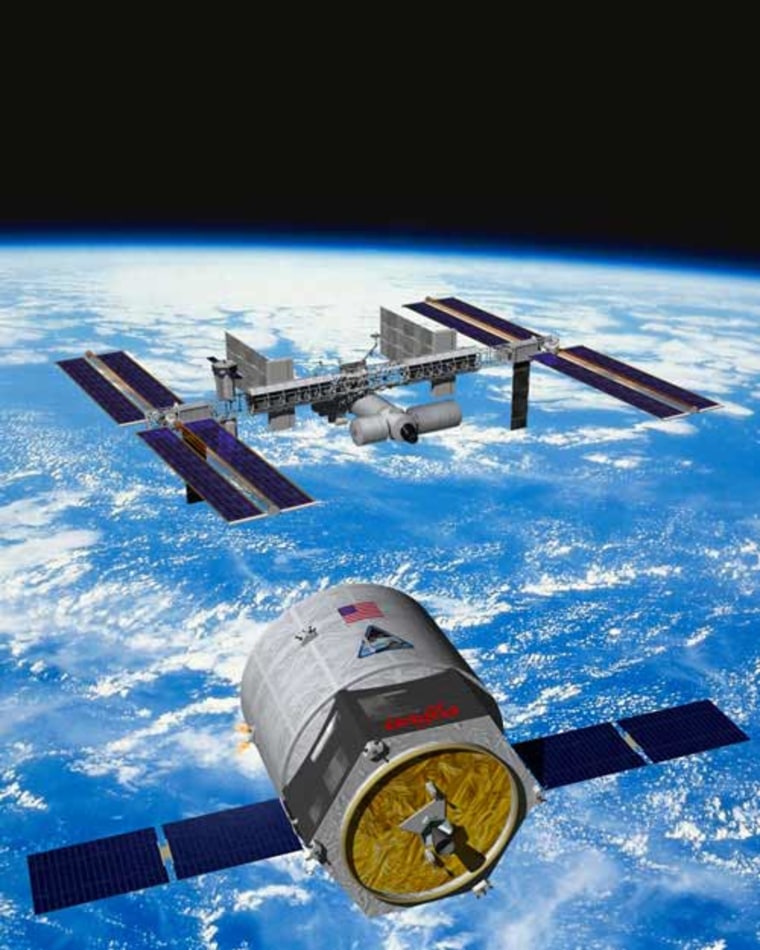The field of commercial spaceflight is ripe with younger companies hoping to make it big with new spaceships, but Orbital Sciences is drawing on nearly 30 years of rocket-launching experience for its effort to build a new vehicle capable of stocking up the International Space Station.
The Virginia-based company is building the unmanned Cygnus space freighter and a new rocket, the Taurus 2, to launch it. The first scheduled demonstration and operational launches are slated for 2011.
"We're not a small, newly-formed company trying to establish a track record of mission success, but we're also not bureaucratically hidebound," said Barron Beneski, vice president of corporate communications for Orbital Sciences. "I don't know that you can really find that combination anywhere else in the industry."
Founded in 1982, Orbital Sciences currently employs about 3,500 people. Its flight record includes years of Pegasus rocket launches for commercial customers, as well as launches of the Minotaur rockets that have served U.S. government and military payloads.
"We let the track record of our products speak for itself," Beneski explained.
Orbital holds a $1.9 billion contract with NASA for eight flights to resupply the space station, and is slated to form an integral part of the new U.S. commercial fleet alongside SpaceX's Falcon 9 rocket and Dragon spacecraft, as well as other boosters.
NASA also has a $1.6 billion contract with the California-based SpaceX (short for Space Exploration Technologies) for unmanned cargo flights to the space station. SpaceX is preparing to launch its first Falcon 9 test flight in the next few months.
From cargo to crew
Orbital's cylindrical Cygnus freighter includes a pressurized cargo module that can carry up to 5,952 pounds of payload. Its service module contains avionics, power, communications and command and control.
"The service module is being designed to human safety standards, because it operates in close proximity with the space station before the robotic arm grapple," Beneski noted.
Orbital also has other prior history with human safety standards, as a lead contractor which helped create the Orion Launch Abort System that would have helped NASA astronauts escape in the event of an emergency involving the now-cancelled Ares I rocket.
"We are probably the industry expert these days in launch abort systems through our work on Orion, so that know-how and capability resides in Orbital," Beneski said.
Slideshow 12 photos
Month in Space: January 2014
Beneski declined to say that Orbital was aiming for certain to carry astronauts into orbit. But he did note that the existing systems put Orbital in a good position to take advantage of such an opportunity.
"Certainly we have the service module which could play a role there, and then the escape system is certainly within Orbital's capability," Beneski said. "We are ready should NASA go down that path."
Orbital's recent launch history includes the failed launch of its Taurus XL rocket last year, which crashed NASA's Orbiting Carbon Observatory into the sea because a payload fairing failed to separate. But the new Taurus 2 offers a new slate.
The company is currently working to develop a new Minotaur 4 rocket for the U.S. military. That rocket is slated for a May 2010 test launch from Alaska.
Walking a middle road
Some critics have fretted about untried commercial launch vehicles doing much of NASA's lifting in the near-future.
Last month, President Barack Obama proposed that NASA cancel its Constellation program building the new Orion spacecraft and Ares rockets in line to replace the agency's space shuttles. Instead, the president directed NASA to set aside funding to support the development of commercial spacecraft capable of launching U.S. astronauts into space.
But commercial spaceflight representatives counter that large aerospace companies have provided the vehicles for NASA all along.
"It's a disservice to focus on the newcomers and leave out the Boeings, Lockheed Martins and General Dynamics that have been in business for 50 years," said Bretton Alexander, president of the Commercial Spaceflight Federation, during a February teleconference with space industry executives and reporters.
Beneski maintains a tempered optimism about the future of commercial spaceflight. But he clearly stated that commercial firms have much of the right stuff to keep U.S. spaceflight alive in the 21st century.
"Under the right circumstances, we believe that the commercial industry — with proper government oversight on safety — can do this," Beneski said.
Readying a rocket
Orbital had already begun developing the Taurus 2 rocket before it received its NASA contract.
The rocket is designed to not only help deliver cargo to the space station, but to also launch medium-class satellites into low-Earth orbit and help fill the gap left by the impending retirement of the Delta 2 rocket sometime in 2011.
"Taurus 2 is a perfect fit as the launcher of a cargo-carrying spacecraft, which we subsequently developed and named Cygnus," Beneski told SPACE.com.
The company has begun testing a pathfinder version of the liquid-fuel AJ26 rocket engine that powers the Taurus 2's first stage at NASA's Stennis Space Center in Mississippi. The engine is a commercial version of one originally designed to help Russia's N-1 rocket fly cosmonauts to the moon during the Cold War.
Beneski anticipates seeing a final delivery of Taurus 2 and the Cygnus spacecraft to Wallops Island, Va. later this year, so that the rocket and spacecraft systems can be combined.

